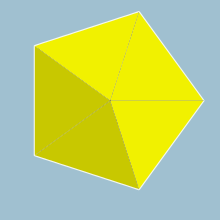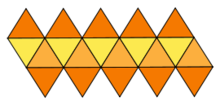Запрос «Икосаэдр» перенаправляется сюда; см. также другие значения.
| Правильный икосаэдр | |||
|---|---|---|---|
 (вращающаяся модель) |
|||
| Тип | правильный многогранник | ||
| Комбинаторика | |||
| Элементы |
|
||
| Грани | правильные треугольники | ||
| Конфигурация вершины | 3.3.3.3.3 | ||
| Двойственный многогранник | правильный додекаэдр | ||
|
Вершинная фигура
|
|||
|
Развёртка
|
|||
| Классификация | |||
| Обозначения |
|
||
| Символ Шлефли | {3,5} | ||
| Символ Витхоффа[en] | 5 | 2 3 | ||
| Диаграмма Дынкина |
|
||
| Группа симметрии |
 |
||
| Группа вращения |
 |
||
| Количественные данные | |||
| Длина ребра |
 |
||
| Площадь поверхности |
 |
||
| Объём |
 |
||
| Двугранный угол |
 |
||
| Телесный угол при вершине |
  ср ср |
||

Икосаэдр и его описанная сфера

Правильный икосаэдр, вписанный в сферу. Видно, что его вершины лежат в четырёх параллельных плоскостях, как доказал Папп Александрийский
Пра́вильный икоса́эдр (от др.-греч. εἴκοσι «двадцать»; ἕδρον «сиденье», «основание») — правильный выпуклый многогранник, двадцатигранник[1], одно из платоновых тел. Каждая из 20 граней представляет собой равносторонний треугольник. Число ребер равно 30, число вершин — 12.
Икосаэдр имеет 59 звёздчатых форм.
История[править | править код]
Евклид в предложении 16 книги XIII «Начал» занимается построением икосаэдра, получая сначала два правильных пятиугольника, лежащих в двух параллельных плоскостях — из десяти его вершин, и затем — две оставшиеся противоположные друг другу вершины[2][3]:127-131. Папп Александрийский в «Математическом собрании» занимается построением икосаэдра, вписанного в данную сферу, попутно доказывая, что двенадцать его вершин лежат в четырёх параллельных плоскостях, образуя в них четыре правильных треугольника[3]:315-316[4].
Основные формулы[править | править код]
Площадь поверхности S, объём V правильного икосаэдра с длиной ребра a, а также радиусы вписанной и описанной сфер вычисляются по формулам:
Площадь:

Объём:

Радиус вписанной сферы[5]:

Радиус полувписанной сферы равен 
Радиус описанной сферы[5]:

Свойства[править | править код]
- Двугранный угол между любыми двумя смежными гранями правильного икосаэдра равен arccos(−√5⁄3) = 138,189685°.
- Все двенадцать вершин правильного икосаэдра лежат по три в четырёх параллельных плоскостях, образуя в каждой из них правильный треугольник.
- Десять вершин правильного икосаэдра лежат в двух параллельных плоскостях, образуя в них два правильных пятиугольника, а остальные две — противоположны друг другу и лежат на двух концах диаметра описанной сферы, перпендикулярного этим плоскостям. Расстояние между симметричными парами вышеупомянутых плоскостей, образованных пятью вершинами равно радиусу круга описываемого вокруг этого пятиугольника (это правило позволяет довольно легко создать 3D-модель правильного икосаэдра).
-

Угол между двумя соседними вершинами относительно центра тела правильного икосаэдра называют икосаэдральным углом. Он равен арккотангенсу 1⁄2 (arcctg 1⁄2 ≈ 63,434949°), или углу между диагональю и меньшей стороной прямоугольника, у которого отношение сторон равно 1:2.
- Правильный икосаэдр можно вписать в куб, при этом шесть взаимно перпендикулярных рёбер икосаэдра будут расположены соответственно на шести гранях куба, остальные 24 ребра внутри куба, все двенадцать вершин икосаэдра будут лежать на шести гранях куба.
- В правильный икосаэдр может быть вписан правильный тетраэдр так, что четыре вершины тетраэдра будут совмещены с четырьмя вершинами икосаэдра.
- Правильный икосаэдр и правильный додекаэдр являются двойственными многогранниками:
- Правильный икосаэдр можно вписать в правильный додекаэдр, при этом вершины икосаэдра будут совмещены с центрами граней додекаэдра.
- В правильный икосаэдр можно вписать правильный додекаэдр с совмещением вершин додекаэдра и центров граней икосаэдра.
- Собрать модель правильного икосаэдра можно при помощи 20 равносторонних треугольников.
- Невозможно собрать правильный икосаэдр из правильных тетраэдров, так как радиус сферы, описанной вокруг икосаэдра, соответственно и длина бокового ребра (от вершины до центра такой сборки) тетраэдра меньше ребра самого икосаэдра. Правильный икосаэдр можно разбить на 20 тетраэдров, соединив вершины икосаэдра с его центром, но эти тетраэдры не являются правильными — угол между их рёбрами при вершине, совпадающей с центром икосаэдра, равен икосаэдральному углу (≈63,434949°), а не 60°, как у правильного тетраэдра.
Усечённый икосаэдр[править | править код]

Усечённый икосаэдр — многогранник, состоящий из 12 правильных пятиугольников и 20 правильных шестиугольников. Имеет икосаэдрический тип симметрии. По сути классический футбольный мяч имеет форму не шара, а усечённого икосаэдра с выпуклыми (сферическими) гранями.
Усечённый икосаэдр может быть получен срезанием 12 вершин с образованием граней в виде правильных пятиугольников. При этом число вершин нового многогранника увеличивается в 5 раз (12×5=60), 20 треугольных граней превращаются в правильные шестиугольники (всего граней становится 20+12=32), а число рёбер возрастает до 30+12×5=90.
В мире[править | править код]
- Икосаэдр лучше всего из всех правильных многогранников подходит для триангуляции сферы методом рекурсивного разбиения[6]. Поскольку он содержит наибольшее среди них количество граней, искажение получающихся треугольников по отношению к правильным минимально.
- Икосаэдр применяется как игральная кость в настольных ролевых играх, и обозначается при этом d20 (dice — кости).
Тела в виде икосаэдра[править | править код]
- Капсиды многих вирусов (например, бактериофаги, мимивирус).
См. также[править | править код]
- Звёздчатый многогранник
Примечания[править | править код]
- ↑ Селиванов Д. Ф.,. Тело геометрическое // Энциклопедический словарь Брокгауза и Ефрона : в 86 т. (82 т. и 4 доп.). — СПб., 1890—1907.
- ↑ Euclid’s Elements, Book XIII, Proposition 16. Дата обращения: 3 сентября 2014. Архивировано 30 августа 2014 года.
- ↑ 1 2 Начала Евклида. Книги XI—XV. — М.—Л.: Государственное издательство технико-теоретической литературы, 1950. — Помимо перевода на русский язык сочинения Евклида это издание в комментариях содержит перевод предложений Паппа о правильных многогранниках.
- ↑ Оригинальный текст на древнегреческом языке с параллельным переводом на латинский язык: Pappi Alexandrini Collectionis. — 1876. — Vol. I. — P. 150—157.
- ↑ 1 2 3 Доказательство приведено в: Cobb, John W. The Icosahedron (англ.) (май 2007). Дата обращения: 3 сентября 2014. Архивировано 4 мая 2016 года.
- ↑ OpenGL Red Book Ch.2 Архивировано 8 января 2015 года.
Литература[править | править код]
- Клейн Ф. Лекции об икосаэдре и решение уравнений пятой степени / Ф. Клейн; пер. с нем. А. Л. Городенцев, А. А. Кириллов, ред. А. Н. Тюрин. — М.: Наука, 1989. — 332 с. — ISBN 5020141976.
-
Вы здесь:
- Главная
- Икосаэдр
Икосаэдр

Древние греки дали многограннику имя по числу граней. «Икоси» означает двадцать, «хедра» – означает грань (Икосаэдр – двадцатигранник).
Поэтому на вопрос – “что такое икосаэдр?”, можно дать следующее определение: “Икосаэдр это геометрическое тело из двадцати граней, каждая их которых – правильный треугольник“.
Многогранник относится к правильным многогранникам и является одним из пяти Платоновых тел.
Икосаэдр имеет следующие характеристики:
- Тип грани – правильный треугольник;
- Число сторон у грани – 3;
- Общее число граней – 20;
- Число рёбер, примыкающих к вершине – 5;
- Общее число вершин – 12;
- Общее число рёбер – 30.
Правильный икосаэдр составлен из двадцати равносторонних треугольников. Каждая вершина икосаэдра является вершиной пяти треугольников. Следовательно, сумма плоских углов при каждой вершине равна 300° (60° x 5).
Икосаэдр имеет центр симметрии – центр икосаэдра, 15 осей симметрии и 15 плоскостей симметрии.
Математические характеристики икосаэдра

Икосаэдр может быть помещен в сферу (вписан), так, что каждая из его вершин будет касаться внутренней стенки сферы.
Радиус описанной сферы икосаэдра

где a – длина стороны.

Сфера может быть вписана внутрь икосаэдра.
Радиус вписанной сферы икосаэдра



Для наглядности площадь поверхности икосаэдра можно представить в виде площади развёртки.
Площадь поверхности можно определить как площадь одной из сторон икосаэдра (это площадь правильного треугольника) умноженной на 20. Либо воспользоваться формулой:


Объем икосаэдра определяется по следующей формуле:

Популярное
Оригами и набор «Волшебные грани»
В этой статье мы постараемся рассказать можно ли наборы «волшебные грани» отнести к разновидности оригами. Как одну и ту же геометрическую фигуру можно получить, используя детали из…
Развертки тел вращения
Что будет, если плоскую геометрическую фигуру, например прямоугольник, начать быстро вращать относительно одной из его сторон?
Одним лишь вращением мы можем…
Домик для птиц
Студией Артемия Лебедева (https://www.artlebedev.ru/) была предложена форма скворечника в виде многогранника.
В качестве геометрической…
Как собирать многогранники без клея?
До сих пор мы активно применяли для сборки многогранников из наборов «Волшебные грани» клей. Более того, настоятельно рекомендовали применять именно клей Супер-ПВА.
Есть ли…
Звезда игры престолов
Популярный телесериал «Игра престолов», интересен не только закрученным сюжетом, игрой актеров и мастерским погружением в эпоху средневековья, но и тем, что активно использует…
Икосаэдр.
Икосаэдр – один из пяти типов правильных многогранников, имеет 20 граней (треугольных), 30 ребер, 12 вершин (в каждой вершине сходятся 5 ребер).
Икосаэдр, как правильный многогранник
Основные формулы икосаэдра
Свойства икосаэдра
Икосаэдр, как правильный многогранник:
Икосаэдр (от др.-греч. εἴκοσι «двадцать»; ἕδρον «сиденье», «основание») – один из пяти типов правильных многогранников, имеет 20 граней (треугольных), 30 ребер, 12 вершин (в каждой вершине сходятся 5 ребер).

Если а – длина ребра икосаэдра, то его объем V = 5/12 · a3 · (3+51/2) ≈ 2,1817 · a3.
Икосаэдр имеет 59 звездчатых форм.
Вершины вписанного икосаэдра лежат в четырёх параллельных плоскостях.
Основные формулы икосаэдра:
Площадь поверхности S, объём V икосаэдра с длиной ребра a, а также радиусы вписанной и описанной сфер вычисляются по формулам:
Площадь поверхности икосаэдра: S = 5 · a2 · 31/2.
Объём икосаэдра: V = 5/12 · a3 · (3+51/2).
Радиус вписанной сферы икосаэдра: R = 1/12 · (42+18 · (5·а)1/2)1/2 = 1/4 · 31/2 · (3+51/2) · а.
Радиус описанной сферы икосаэдра: R = 1/4 · (2 · (5+51/2))1/2 · a.
Свойства икосаэдра:
– двугранный угол между любыми двумя смежными гранями икосаэдра равен arccos(-√5/3) = 138,189685°;
– телесный угол при вершине икосаэдра равен 2·π – 5·arcsin(2/3) ≈ 2,63455 cp (стерадиан);
– все двенадцать вершин икосаэдра лежат по три в четырёх параллельных плоскостях, образуя в каждой из них правильный треугольник;
– десять вершин икосаэдра лежат в двух параллельных плоскостях, образуя в них два правильных пятиугольника, а остальные две — противоположны друг другу и лежат на двух концах диаметра описанной сферы, перпендикулярного этим плоскостям;
– икосаэдр можно вписать в куб, при этом шесть взаимно перпендикулярных рёбер икосаэдра будут расположены соответственно на шести гранях куба, остальные 24 ребра внутри куба, все двенадцать вершин икосаэдра будут лежать на шести гранях куба;
– в икосаэдр может быть вписан тетраэдр, так что четыре вершины тетраэдра будут совмещены с четырьмя вершинами икосаэдра;
– икосаэдр можно вписать в додекаэдр, при этом вершины икосаэдра будут совмещены с центрами граней додекаэдра;
– в икосаэдр можно вписать додекаэдр с совмещением вершин додекаэдра и центров граней икосаэдра;
– усечённый икосаэдр может быть получен срезанием 12 вершин с образованием граней в виде правильных пятиугольников. При этом число вершин нового многогранника увеличивается в 5 раз (12×5=60), 20 треугольных граней превращаются в правильные шестиугольники (всего граней становится 20+12=32), а число рёбер возрастает до 30+12×5=90;
– собрать модель икосаэдра можно при помощи 20 равносторонних треугольников;
– невозможно собрать икосаэдр из правильных тетраэдров, так как радиус описанной сферы вокруг икосаэдра, соответственно и длина бокового ребра (от вершины до центра такой сборки) тетраэдра меньше ребра самого икосаэдра.
Источник: https://ru.wikipedia.org/wiki/Правильный_икосаэдр
Примечание: © Фото //www.pexels.com, //pixabay.com
Коэффициент востребованности
2 882
| Regular icosahedron | |
|---|---|
 (Click here for rotating model) |
|
| Type | Platonic solid |
| Elements | F = 20, E = 30 V = 12 (χ = 2) |
| Faces by sides | 20{3} |
| Conway notation | I sT |
| Schläfli symbols | {3,5} |
| s{3,4} sr{3,3} or 
|
|
| Face configuration | V5.5.5 |
| Wythoff symbol | 5 | 2 3 |
| Coxeter diagram | |
| Symmetry | Ih, H3, [5,3], (*532) |
| Rotation group | I, [5,3]+, (532) |
| References | U22, C25, W4 |
| Properties | regular, convexdeltahedron |
| Dihedral angle | 138.189685° = arccos(−√5⁄3) |
 3.3.3.3.3 (Vertex figure) |
 Regular dodecahedron (dual polyhedron) |
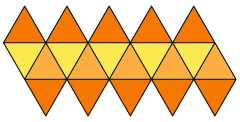 Net |

3D model of a regular icosahedron
In geometry, a regular icosahedron ( or [1]) is a convex polyhedron with 20 faces, 30 edges and 12 vertices. It is one of the five Platonic solids, and the one with the most faces.
It has five equilateral triangular faces meeting at each vertex. It is represented by its Schläfli symbol {3,5}, or sometimes by its vertex figure as 3.3.3.3.3 or 35. It is the dual of the regular dodecahedron, which is represented by {5,3}, having three pentagonal faces around each vertex. In most contexts, the unqualified use of the word “icosahedron” refers specifically to this figure.
A regular icosahedron is a strictly convex deltahedron and a gyroelongated pentagonal bipyramid and a biaugmented pentagonal antiprism in any of six orientations.
The name comes from Greek εἴκοσι (eíkosi) ‘twenty’, and ἕδρα (hédra) ‘seat’. The plural can be either “icosahedrons” or “icosahedra” ().
Dimensions[edit]

Net folding into icosahedron
If the edge length of a regular icosahedron is 
and the radius of an inscribed sphere (tangent to each of the icosahedron’s faces) is
while the midradius, which touches the middle of each edge, is
where 
Area and volume[edit]
The surface area 


The latter is F = 20 times the volume of a general tetrahedron with apex at the center of the
inscribed sphere, where the volume of the tetrahedron is one third times the base area 

The volume filling factor of the circumscribed sphere is:
compared to 66.49% for a dodecahedron. A sphere inscribed in an icosahedron will enclose 89.635% of its volume, compared to only 75.47% for a dodecahedron.
The midsphere of an icosahedron will have a volume 1.01664 times the volume of the icosahedron, which is by far the closest similarity in volume of any platonic solid with its midsphere. This arguably makes the icosahedron the “roundest” of the platonic solids.
Cartesian coordinates[edit]

Icosahedron vertices form three orthogonal golden rectangles
The vertices of an icosahedron centered at the origin with an edge length of 2 and a circumradius of 
where 
The vertices of the icosahedron form five sets of three concentric, mutually orthogonal golden rectangles, whose edges form Borromean rings.
If the original icosahedron has edge length 1, its dual dodecahedron has edge length 
Model of an icosahedron made with metallic spheres and magnetic connectors
The 12 edges of a regular octahedron can be subdivided in the golden ratio so that the resulting vertices define a regular icosahedron. This is done by first placing vectors along the octahedron’s edges such that each face is bounded by a cycle, then similarly subdividing each edge into the golden mean along the direction of its vector. The five octahedra defining any given icosahedron form a regular polyhedral compound, while the two icosahedra that can be defined in this way from any given octahedron form a uniform polyhedron compound.

The vertices of an icosahedron centred at the origin with an edge length of 
Spherical coordinates[edit]
The locations of the vertices of a regular icosahedron can be described using spherical coordinates, for instance as latitude and longitude. If two vertices are taken to be at the north and south poles (latitude ±90°), then the other ten vertices are at latitude ± arctan 1/2 = ±26.57°. These ten vertices are at evenly spaced longitudes (36° apart), alternating between north and south latitudes.
This scheme takes advantage of the fact that the regular icosahedron is a pentagonal gyroelongated bipyramid, with D5d dihedral symmetry—that is, it is formed of two congruent pentagonal pyramids joined by a pentagonal antiprism.
Orthogonal projections[edit]
The icosahedron has three special orthogonal projections, centered on a face, an edge and a vertex:
| Centered by | Face | Edge | Vertex |
|---|---|---|---|
| Coxeter plane | A2 | A3 | H3 |
| Graph | 
|

|
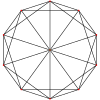
|
| Projective symmetry |
[6] | [2] | [10] |
| Graph |  Face normal |
 Edge normal |
 Vertex normal |
As a configuration[edit]
This configuration matrix represents the icosahedron. The rows and columns correspond to vertices, edges, and faces. The diagonal numbers say how many of each element occur in the whole icosahedron. The nondiagonal numbers say how many of the column’s element occur in or at the row’s element.[3][4]

Here is the configuration expanded with k-face elements and k-figures. The diagonal element counts are the ratio of the full Coxeter group H3, order 120, divided by the order of the subgroup with mirror removal.
| H3 | k-face | fk | f0 | f1 | f2 | k-fig | Notes | |
|---|---|---|---|---|---|---|---|---|
| A2 | ( ) | f0 | 12 | 5 | 5 | {5} | H3/H2 = 120/10 = 12 | |
| A1A1 | { } | f1 | 2 | 30 | 2 | { } | H3/A1A1 = 120/4 = 30 | |
| H2 | {3} | f2 | 3 | 3 | 20 | ( ) | H3/A2 = 120/6 = 20 |
Spherical tiling[edit]
The icosahedron can also be represented as a spherical tiling, and projected onto the plane via a stereographic projection. This projection is conformal, preserving angles but not areas or lengths. Straight lines on the sphere are projected as circular arcs on the plane.

|

|
| Orthographic projection | Stereographic projection |
|---|
Other facts[edit]
- An icosahedron has 43,380 distinct nets.[5]
- To color the icosahedron, such that no two adjacent faces have the same color, requires at least 3 colors.[a]
- A problem dating back to the ancient Greeks is to determine which of two shapes has larger volume, an icosahedron inscribed in a sphere, or a dodecahedron inscribed in the same sphere. The problem was solved by Hero, Pappus, and Fibonacci, among others.[6] Apollonius of Perga discovered the curious result that the ratio of volumes of these two shapes is the same as the ratio of their surface areas.[7] Both volumes have formulas involving the golden ratio, but taken to different powers.[8] As it turns out, the icosahedron occupies less of the sphere’s volume (60.54%) than the dodecahedron (66.49%).[9]
- Icosahedral angle – the angle between the closest vertices of the icosahedron, relative to the center of the body of the icosahedron (3D), is equal to the diagonal angle of a double and / or half square (≈ 63.434949°)
Construction by a system of equiangular lines[edit]
The following construction of the icosahedron avoids tedious computations in the number field ![{displaystyle mathbb {Q} [{sqrt {5}}]}](https://wikimedia.org/api/rest_v1/media/math/render/svg/5691f5e84ebcf23acbd458f90f57c0945549be8c)
The existence of the icosahedron amounts to the existence of six equiangular lines in 
In order to construct such an equiangular system, we start with this 6 × 6 square matrix:
A straightforward computation yields 





The matrix 











A second straightforward construction of the icosahedron uses representation theory of the alternating group 
Symmetry[edit]

Full Icosahedral symmetry has 15 mirror planes (seen as cyan great circles on this sphere) meeting at order 
The rotational symmetry group of the regular icosahedron is isomorphic to the alternating group on five letters. This non-abelian simple group is the only non-trivial normal subgroup of the symmetric group on five letters. Since the Galois group of the general quintic equation is isomorphic to the symmetric group on five letters, and this normal subgroup is simple and non-abelian, the general quintic equation does not have a solution in radicals. The proof of the Abel–Ruffini theorem uses this simple fact, and Felix Klein wrote a book that made use of the theory of icosahedral symmetries to derive an analytical solution to the general quintic equation, (Klein 1884). See icosahedral symmetry: related geometries for further history, and related symmetries on seven and eleven letters.
The full symmetry group of the icosahedron (including reflections) is known as the full icosahedral group, and is isomorphic to the product of the rotational symmetry group and the group 
Stellations[edit]
The icosahedron has a large number of stellations. According to specific rules defined in the book The Fifty-Nine Icosahedra,[10] 59 stellations were identified for the regular icosahedron. The first form is the icosahedron itself. One is a regular Kepler–Poinsot polyhedron. Three are regular compound polyhedra.
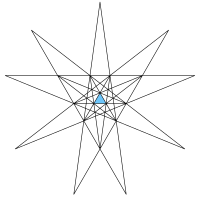 The faces of the icosahedron extended outwards as planes intersect, defining regions in space as shown by this stellation diagram of the intersections in a single plane. |

|

|

|

|

|

|
|

|

|

|

|
||||

|

|

|

|

|
Facetings[edit]
The small stellated dodecahedron, great dodecahedron, and great icosahedron are three facetings of the regular icosahedron. They share the same vertex arrangement. They all have 30 edges. The regular icosahedron and great dodecahedron share the same edge arrangement but differ in faces (triangles vs pentagons), as do the small stellated dodecahedron and great icosahedron (pentagrams vs triangles).
| Convex | Regular stars | ||
|---|---|---|---|
| icosahedron | great dodecahedron | small stellated dodecahedron | great icosahedron |

|

|

|

|
Geometric relations[edit]
Inscribed in other Platonic solids[edit]
The regular icosahedron is the dual polyhedron of the regular dodecahedron. An icosahedron can be inscribed in a dodecahedron by placing its vertices at the face centers of the dodecahedron, and vice versa.
An icosahedron can be inscribed in an octahedron by placing its 12 vertices on the 12 edges of the octahedron such that they divide each edge into its two golden sections. Because the golden sections are unequal, there are five different ways to do this consistently, so five disjoint icosahedra can be inscribed in each octahedron.[11]
An icosahedron of edge length 
Relations to the 600-cell and other 4-polytopes[edit]
The icosahedron is the dimensional analogue of the 600-cell, a regular 4-dimensional polytope. The 600-cell has icosahedral cross sections of two sizes, and each of its 120 vertices is an icosahedral pyramid; the icosahedron is the vertex figure of the 600-cell.
The unit-radius 600-cell has tetrahedral cells of edge length 

A semiregular 4-polytope, the snub 24-cell, has icosahedral cells.
Relations to other uniform polytopes[edit]
The icosahedron is unique among the Platonic solids in possessing a dihedral angle not less than 120°. Its dihedral angle is approximately 138.19°. Thus, just as hexagons have angles not less than 120° and cannot be used as the faces of a convex regular polyhedron because such a construction would not meet the requirement that at least three faces meet at a vertex and leave a positive defect for folding in three dimensions, icosahedra cannot be used as the cells of a convex regular polychoron because, similarly, at least three cells must meet at an edge and leave a positive defect for folding in four dimensions (in general for a convex polytope in n dimensions, at least three facets must meet at a peak and leave a positive defect for folding in n-space). However, when combined with suitable cells having smaller dihedral angles, icosahedra can be used as cells in semi-regular polychora (for example the snub 24-cell), just as hexagons can be used as faces in semi-regular polyhedra (for example the truncated icosahedron). Finally, non-convex polytopes do not carry the same strict requirements as convex polytopes, and icosahedra are indeed the cells of the icosahedral 120-cell, one of the ten non-convex regular polychora.
There are distortions of the icosahedron that, while no longer regular, are nevertheless vertex-uniform. These are invariant under the same rotations as the tetrahedron, and are somewhat analogous to the snub cube and snub dodecahedron, including some forms which are chiral and some with Th-symmetry, i.e. have different planes of symmetry from the tetrahedron.
An icosahedron can also be called a gyroelongated pentagonal bipyramid. It can be decomposed into a gyroelongated pentagonal pyramid and a pentagonal pyramid or into a pentagonal antiprism and two equal pentagonal pyramids.
Relation to the 6-cube and rhombic triacontahedron[edit]
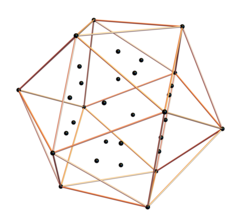
The icosahedron can be projected to 3D from the 6D 6-demicube using the same basis vectors that form the hull of the Rhombic triacontahedron from the 6-cube. Shown here including the inner 20 vertices which are not connected by the 30 outer hull edges of 6D norm length 
The 3D projection basis vectors [u,v,w] used are:
Symmetries[edit]

There are 3 uniform colorings of the icosahedron. These colorings can be represented as 11213, 11212, 11111, naming the 5 triangular faces around each vertex by their color.
The icosahedron can be considered a snub tetrahedron, as snubification of a regular tetrahedron gives a regular icosahedron having chiral tetrahedral symmetry. It can also be constructed as an alternated truncated octahedron, having pyritohedral symmetry. The pyritohedral symmetry version is sometimes called a pseudoicosahedron, and is dual to the pyritohedron.
| Regular | Uniform | 2-uniform | 3-uniform | ||||
|---|---|---|---|---|---|---|---|
| Name | Regular icosahedron |
Snub octahedron |
Snub tetratetrahedron |
Gyroelongated pentagonal bipyramid |
Triangular gyrobianticupola |
Snub triangular antiprism[13] |
Snub square bipyramid |
| Image | 
|

|

|

|

|

|

|
| Face coloring |
(11111) | (11212) | (11213) | (11122) (22222) |
(12332) (23333) |
(11213) (11212) |
(11424) (22434) (33414) |
| Coxeter diagram |
|||||||
| Schläfli symbol |
{3,5} | s{3,4} | sr{3,3} | () || {n} || r{n} || () | ss{2,6} | sdt{2,4} | |
| Conway | I | HtO | sT | k5A5 | sY3 = HtA3 | HtdP4 | |
| Symmetry | Ih [5,3] (*532) |
Th [3+,4] (3*2) |
T [3,3]+ (332) |
D5d [2+,10] (2*5) |
D3d [2+,6] (2*3) |
D3 [3,2]+ (322) |
D2h [2,2] (*222) |
| Symmetry order |
120 | 24 | 12 | 20 | 12 | 6 | 8 |
Uses and natural forms[edit]
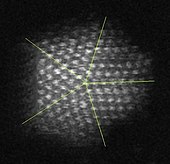

Biology[edit]
Many viruses, e.g. herpes virus, have icosahedral shells.[14] Viral structures are built of repeated identical protein subunits known as capsomeres, and the icosahedron is the easiest shape to assemble using these subunits. A regular polyhedron is used because it can be built from a single basic unit protein used over and over again; this saves space in the viral genome.
Various bacterial organelles with an icosahedral shape were also found.[15] The icosahedral shell encapsulating enzymes and labile intermediates are built of different types of proteins with BMC domains.
In 1904, Ernst Haeckel described a number of species of Radiolaria, including Circogonia icosahedra, whose skeleton is shaped like a regular icosahedron. A copy of Haeckel’s illustration for this radiolarian appears in the article on regular polyhedra.
Chemistry[edit]
The closo-carboranes are chemical compounds with shape very close to icosahedron. Icosahedral twinning also occurs in crystals, especially nanoparticles.
Many borides and allotropes of boron contain boron B12 icosahedron as a basic structure unit.
Toys and games[edit]

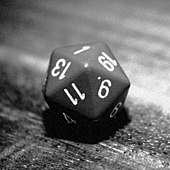
Icosahedral dice with twenty sides have been used since ancient times.[16]
In several roleplaying games, such as Dungeons & Dragons, the twenty-sided die (d20 for short) is commonly used in determining success or failure of an action. This die is in the form of a regular icosahedron. It may be numbered from “0” to “9” twice (in which form it usually serves as a ten-sided die, or d10), but most modern versions are labeled from “1” to “20”.
An icosahedron is used in the board game Scattergories to choose a letter of the alphabet. Six letters are omitted (Q, U, V, X, Y, and Z).
In the Nintendo 64 game Kirby 64: The Crystal Shards, the boss Miracle Matter is a regular icosahedron.
Inside a Magic 8-Ball, various answers to yes–no questions are inscribed on a regular icosahedron.
Tensegrity[edit]
The octahedron has been widely studied in the field of tensegrity. Due to its spherical symmetry and high strength to mass ratio, the shape became a good candidate for deployable tensegrity space structures such as NASA’s SuperBALL.[17] The robot is composed of rods, cables and actuators of different scales and is currently in development between NASA Ames Research Center’s Intelligent Robotics Group and the Dynamic Tensegrity Robotics Lab (DTRL). Its undeployed configuration is highly compact, hence being ideal for fitting within the space-constraints of rocket fairings.[18]
The Icosahedron in tensegrity is composed of six struts and twenty-four cables that connect twelve nodes. One self-stress state is present within the combination achieved through the use of cellular morphogenesis.[19]
Others[edit]
R. Buckminster Fuller and Japanese cartographer Shoji Sadao[20] designed a world map in the form of an unfolded icosahedron, called the Fuller projection, whose maximum distortion is only 2%.
The American electronic music duo ODESZA use a regular icosahedron as their logo.
Icosahedral graph[edit]
| Regular icosahedron graph | |
|---|---|

3-fold symmetry |
|
| Vertices | 12 |
| Edges | 30 |
| Radius | 3 |
| Diameter | 3 |
| Girth | 3 |
| Automorphisms | 120 (A5 × Z2) |
| Chromatic number | 4 |
| Properties | Hamiltonian, regular, symmetric, distance-regular, distance-transitive, 3-vertex-connected, planar graph |
| Table of graphs and parameters |
The skeleton of the icosahedron (the vertices and edges) forms a graph. It is one of 5 Platonic graphs, each a skeleton of its Platonic solid.
The high degree of symmetry of the polygon is replicated in the properties of this graph, which is distance-transitive and symmetric. The automorphism group has order 120. The vertices can be colored with 4 colors, the edges with 5 colors, and the diameter is 3.[21]
The icosahedral graph is Hamiltonian: there is a cycle containing all the vertices. It is also a planar graph.

|
Diminished regular icosahedra[edit]
There are 4 related Johnson solids, including pentagonal faces with a subset of the 12 vertices. The similar dissected regular icosahedron has 2 adjacent vertices diminished, leaving two trapezoidal faces, and a bifastigium has 2 opposite sets of vertices removed and 4 trapezoidal faces. The pentagonal antiprism is formed by removing two opposite vertices.
| Form | J2 | Bifastigium | J63 | J62 | Dissected icosahedron |
s{2,10} | J11 |
|---|---|---|---|---|---|---|---|
| Vertices | 6 of 12 | 8 of 12 | 9 of 12 | 10 of 12 | 11 of 12 | ||
| Symmetry | C5v, [5], (*55) order 10 |
D2h, [2,2], *222 order 8 |
C3v, [3], (*33) order 6 |
C2v, [2], (*22) order 4 |
D5d, [2+,10], (2*5) order 20 |
C5v, [5], (*55) order 10 |
|
| Image | 
|

|

|

|

|

|
Related polyhedra and polytopes[edit]
The icosahedron can be transformed by a truncation sequence into its dual, the dodecahedron:
| Family of uniform icosahedral polyhedra | |||||||
|---|---|---|---|---|---|---|---|
| Symmetry: [5,3], (*532) | [5,3]+, (532) | ||||||

|

|

|

|

|

|

|

|
| {5,3} | t{5,3} | r{5,3} | t{3,5} | {3,5} | rr{5,3} | tr{5,3} | sr{5,3} |
| Duals to uniform polyhedra | |||||||

|

|

|

|

|
|||
| V5.5.5 | V3.10.10 | V3.5.3.5 | V5.6.6 | V3.3.3.3.3 | V3.4.5.4 | V4.6.10 | V3.3.3.3.5 |
As a snub tetrahedron, and alternation of a truncated octahedron it also exists in the tetrahedral and octahedral symmetry families:
| Family of uniform tetrahedral polyhedra | |||||||
|---|---|---|---|---|---|---|---|
| Symmetry: [3,3], (*332) | [3,3]+, (332) | ||||||

|

|

|

|
||||
| {3,3} | t{3,3} | r{3,3} | t{3,3} | {3,3} | rr{3,3} | tr{3,3} | sr{3,3} |
| Duals to uniform polyhedra | |||||||

|

|

|

|
||||
| V3.3.3 | V3.6.6 | V3.3.3.3 | V3.6.6 | V3.3.3 | V3.4.3.4 | V4.6.6 | V3.3.3.3.3 |
| Uniform octahedral polyhedra | ||||||||||
|---|---|---|---|---|---|---|---|---|---|---|
| Symmetry: [4,3], (*432) | [4,3]+ (432) |
[1+,4,3] = [3,3] (*332) |
[3+,4] (3*2) |
|||||||
| {4,3} | t{4,3} | r{4,3} r{31,1} |
t{3,4} t{31,1} |
{3,4} {31,1} |
rr{4,3} s2{3,4} |
tr{4,3} | sr{4,3} | h{4,3} {3,3} |
h2{4,3} t{3,3} |
s{3,4} s{31,1} |
= |
= |
= |
||||||||
| Duals to uniform polyhedra | ||||||||||
| V43 | V3.82 | V(3.4)2 | V4.62 | V34 | V3.43 | V4.6.8 | V34.4 | V33 | V3.62 | V35 |
This polyhedron is topologically related as a part of sequence of regular polyhedra with Schläfli symbols {3,n}, continuing into the hyperbolic plane.
*n32 symmetry mutation of regular tilings: {3,n}
|
|||||||||||
|---|---|---|---|---|---|---|---|---|---|---|---|
| Spherical | Euclid. | Compact hyper. | Paraco. | Noncompact hyperbolic | |||||||

|

|

|

|

|

|

|

|

|

|

|

|
| 3.3 | 33 | 34 | 35 | 36 | 37 | 38 | 3∞ | 312i | 39i | 36i | 33i |
The regular icosahedron, seen as a snub tetrahedron, is a member of a sequence of snubbed polyhedra and tilings with vertex figure (3.3.3.3.n) and Coxeter–Dynkin diagram ![]()
![]()
![]()
![]()
![]() . These figures and their duals have (n32) rotational symmetry, being in the Euclidean plane for
. These figures and their duals have (n32) rotational symmetry, being in the Euclidean plane for 


n32 symmetry mutations of snub tilings: 3.3.3.3.n
|
||||||||
|---|---|---|---|---|---|---|---|---|
| Symmetry n32 |
Spherical | Euclidean | Compact hyperbolic | Paracomp. | ||||
| 232 | 332 | 432 | 532 | 632 | 732 | 832 | ∞32 | |
| Snub figures |

|

|

|

|

|

|

|

|
| Config. | 3.3.3.3.2 | 3.3.3.3.3 | 3.3.3.3.4 | 3.3.3.3.5 | 3.3.3.3.6 | 3.3.3.3.7 | 3.3.3.3.8 | 3.3.3.3.∞ |
| Gyro figures |

|

|

|

|

|

|

|

|
| Config. | V3.3.3.3.2 | V3.3.3.3.3 | V3.3.3.3.4 | V3.3.3.3.5 | V3.3.3.3.6 | V3.3.3.3.7 | V3.3.3.3.8 | V3.3.3.3.∞ |
| Spherical | Hyperbolic tilings
|
|||||||
|---|---|---|---|---|---|---|---|---|
 {2,5} |
 {3,5} |
 {4,5} |
 {5,5} |
 {6,5} |
 {7,5} |
 {8,5} |
… |  {∞,5} |
The icosahedron can tessellate hyperbolic space in the order-3 icosahedral honeycomb, with 3 icosahedra around each edge, 12 icosahedra around each vertex, with Schläfli symbol {3,5,3}. It is one of four regular tessellations in the hyperbolic 3-space.

It is shown here as an edge framework in a Poincaré disk model, with one icosahedron visible in the center.
See also[edit]
- Great icosahedron
- Geodesic grids use an iteratively bisected icosahedron to generate grids on a sphere
- Icosahedral twins
- Infinite skew polyhedron
- Jessen’s icosahedron
- Regular polyhedron
- Truncated icosahedron
Notes[edit]
- ^ This is true for all convex polyhedra with triangular faces except for the tetrahedron, by applying Brooks’ theorem to the dual graph of the polyhedron.
- ^ Reciprocally, the edge length of a cube inscribed in a dodecahedron is in the golden ratio to the dodecahedron’s edge length. The cube’s edges lie in pentagonal face planes of the dodecahedron as regular pentagon diagonals, which are always in the golden ratio to the regular pentagon’s edge. So when a cube is inscribed in a dodecahedron and an icosahedron is inscribed in the cube, the dodecahedron and icosahedron (which do not share any vertices) have the same edge length.
Citations[edit]
- ^ Jones, Daniel (2003) [1917], Peter Roach; James Hartmann; Jane Setter (eds.), English Pronouncing Dictionary, Cambridge: Cambridge University Press, ISBN 3-12-539683-2
- ^ Weisstein, Eric W. “Icosahedral group”. MathWorld.
- ^ Coxeter, Regular Polytopes, sec 1.8 Configurations
- ^ Coxeter, Complex Regular Polytopes, p.117
- ^ Weisstein, Eric W. “Regular Icosahedron”. MathWorld.
- ^ Herz-Fischler, Roger (2013), A Mathematical History of the Golden Number, Courier Dover Publications, pp. 138–140, ISBN 9780486152325.
- ^ Simmons, George F. (2007), Calculus Gems: Brief Lives and Memorable Mathematics, Mathematical Association of America, p. 50, ISBN 9780883855614.
- ^ Sutton, Daud (2002), Platonic & Archimedean Solids, Wooden Books, Bloomsbury Publishing USA, p. 55, ISBN 9780802713865.
- ^ Numerical values for the volumes of the inscribed Platonic solids may be found in Buker, W. E.; Eggleton, R. B. (1969), “The Platonic Solids (Solution to problem E2053)”, American Mathematical Monthly, 76 (2): 192, doi:10.2307/2317282, JSTOR 2317282.
- ^ Coxeter et al. 1938.
- ^ Coxeter et al. 1938, p. 4; “Just as a tetrahedron can be inscribed in a cube, so a cube can be inscribed in a dodecahedron. By reciprocation, this leads to an octahedron circumscribed about an icosahedron. In fact, each of the twelve vertices of the icosahedron divides an edge of the octahedron according to the “golden section”. Given the icosahedron, the circumscribed octahedron can be chosen in five ways, giving a compound of five octahedra, which comes under our definition of stellated icosahedron. (The reciprocal compound, of five cubes whose vertices belong to a dodecahedron, is a stellated triacontahedron.) Another stellated icosahedron can at once be deduced, by stellating each octahedron into a stella octangula, thus forming a compound of ten tetrahedra. Further, we can choose one tetrahedron from each stella octangula, so as to derive a compound of five tetrahedra, which still has all the rotation symmetry of the icosahedron (i.e. the icosahedral group), although it has lost the reflections. By reflecting this figure in any plane of symmetry of the icosahedron, we obtain the complementary set of five tetrahedra. These two sets of five tetrahedra are enantiomorphous, i.e. not directly congruent, but related like a pair of shoes. [Such] a figure which possesses no plane of symmetry (so that it is enantiomorphous to its mirror-image) is said to be chiral.”
- ^ Borovik 2006, pp. 8–9, §5. How to draw an icosahedron on a blackboard.
- ^ Snub Anti-Prisms
- ^ C. Michael Hogan. 2010. Virus. Encyclopedia of Earth. National Council for Science and the Environment. eds. S. Draggan and C. Cleveland
- ^ Bobik, T.A. (2007), “Bacterial Microcompartments”, Microbe, Am. Soc. Microbiol., 2: 25–31, archived from the original on 2013-07-29
- ^ Cromwell, Peter R. “Polyhedra” (1997) Page 327.
- ^ Sabelhaus, Andrew P.; Bruce, Jonathan; Caluwaerts, Ken; Chen, Yangxin; Lu, Dizhou; Liu, Yuejia; Agogino, Adrian K.; SunSpiral, Vytas; Agogino, Alice M. (2014-07-15). “Hardware Design and Testing of SUPERball, A Modular Tensegrity Robot”.
- ^ “NASA’s Super Ball Bot Could Be the Best Design for Planetary Exploration”. IEEE Spectrum. 2015-03-02. Retrieved 2022-12-22.
- ^ Aloui, Omar; Flores, Jessica; Orden, David; Rhode-Barbarigos, Landolf (2019-04-01). “Cellular morphogenesis of three-dimensional tensegrity structures”. Computer Methods in Applied Mechanics and Engineering. 346: 85–108. arXiv:1902.09953. doi:10.1016/j.cma.2018.10.048. ISSN 0045-7825. S2CID 67856423.
- ^ “Fuller and Sadao: Partners in Design”. September 19, 2006. Archived from the original on August 16, 2010. Retrieved 2010-01-26.
- ^ Weisstein, Eric W. “Icosahedral Graph”. MathWorld.
References[edit]
- Klein, Felix (1888), Lectures on the ikosahedron and the solution of equations of the fifth degree, ISBN 978-0-486-49528-6, Dover edition
{{citation}}: CS1 maint: postscript (link), translated from Klein, Felix (1884). Vorlesungen über das Ikosaeder und die Auflösung der Gleichungen vom fünften Grade. Teubner. - Coxeter, H.S.M.; du Val, Patrick; Flather, H.T.; Petrie, J.F. (1938). The Fifty-Nine Icosahedra. Vol. 6. University of Toronto Studies (Mathematical Series).
- Borovik, Alexandre (2006). “Coxeter Theory: The Cognitive Aspects”. In Davis, Chandler; Ellers, Erich (eds.). The Coxeter Legacy. Providence, Rhode Island: American Mathematical Society. pp. 17–43. ISBN 978-0821837221.
External links[edit]
![]()
![]()
Look up icosahedron in Wiktionary, the free dictionary.
- Klitzing, Richard. “3D convex uniform polyhedra x3o5o – ike”.
- Hartley, Michael. “Dr Mike’s Math Games for Kids”.
- K.J.M. MacLean, A Geometric Analysis of the Five Platonic Solids and Other Semi-Regular Polyhedra
- Virtual Reality Polyhedra The Encyclopedia of Polyhedra
- Tulane.edu A discussion of viral structure and the icosahedron
- Origami Polyhedra – Models made with Modular Origami
- Video of icosahedral mirror sculpture
- [1] Principle of virus architecture
Fundamental convex regular and uniform polytopes in dimensions 2–10 |
|||||
|---|---|---|---|---|---|
| Family | An | Bn | I2(p) / Dn | E6 / E7 / E8 / F4 / G2 | Hn |
| Regular polygon | Triangle | Square | p-gon | Hexagon | Pentagon |
| Uniform polyhedron | Tetrahedron | Octahedron • Cube | Demicube | Dodecahedron • Icosahedron | |
| Uniform polychoron | Pentachoron | 16-cell • Tesseract | Demitesseract | 24-cell | 120-cell • 600-cell |
| Uniform 5-polytope | 5-simplex | 5-orthoplex • 5-cube | 5-demicube | ||
| Uniform 6-polytope | 6-simplex | 6-orthoplex • 6-cube | 6-demicube | 122 • 221 | |
| Uniform 7-polytope | 7-simplex | 7-orthoplex • 7-cube | 7-demicube | 132 • 231 • 321 | |
| Uniform 8-polytope | 8-simplex | 8-orthoplex • 8-cube | 8-demicube | 142 • 241 • 421 | |
| Uniform 9-polytope | 9-simplex | 9-orthoplex • 9-cube | 9-demicube | ||
| Uniform 10-polytope | 10-simplex | 10-orthoplex • 10-cube | 10-demicube | ||
| Uniform n-polytope | n-simplex | n-orthoplex • n-cube | n-demicube | 1k2 • 2k1 • k21 | n-pentagonal polytope |
| Topics: Polytope families • Regular polytope • List of regular polytopes and compounds |
| Notable stellations of the icosahedron | |||||||||
| Regular | Uniform duals | Regular compounds | Regular star | Others | |||||
| (Convex) icosahedron | Small triambic icosahedron | Medial triambic icosahedron | Great triambic icosahedron | Compound of five octahedra | Compound of five tetrahedra | Compound of ten tetrahedra | Great icosahedron | Excavated dodecahedron | Final stellation |
|---|---|---|---|---|---|---|---|---|---|
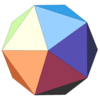
|

|

|
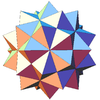
|
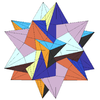
|

|

|
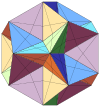
|

|
|
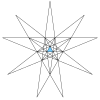
|

|

|

|

|

|

|

|

|
|
| The stellation process on the icosahedron creates a number of related polyhedra and compounds with icosahedral symmetry. |
Правильные многогранники
Существует всего пять правильных многогранников:
- Тетраэдр
- Куб (Гексаэдр)
- Октаэдр
- Икосаэдр
- Додекаэдр
Если какое-то из этих названий звучит для тебя как древний эльфийский язык, обязательно прочитай эту статью!
Давай посмотрим, как они выглядят, и разберем основные формулы – площади поверхности, объема, радиусов вписанной и описанной сферы.
А также решим задачу №8.
О том, как рисовать пространственные фигуры на плоскости, можно прочитать в нашей статье: «Изображение пространственных фигур. Визуальный гид».
Поехали!
Правильные многогранники — подробнее
Многогранник называется правильным, если:
- он выпуклый;
- все его грани являются правильными многоугольниками;
- в каждой его вершине сходится одинаковое число его ребер.
Пять правильных многогранников
Тетраэдр
Тетраэдр состоит из четырёх равносторонних треугольников.
Фигура имеет 4 грани, 4 вершины и 6 ребер(a).
Площадь поверхности тетраэдра:
( displaystyle S={{a}^{2}}sqrt{3})
Объем тетраэдра:
( displaystyle V=frac{{{a}^{3}}}{12}sqrt{2})
Радиус описанной вокруг тетраэдра сферы:
( displaystyle R=frac{a}{4}sqrt{6})
Радиус вписанной в тетраэдр сферы:
( displaystyle R=frac{a}{12}sqrt{6})
Куб (Гексаэдр)
Куб состоит из шести квадратов.
Фигура имеет 6 граней, 8 вершин и 12 ребер (a).
Площадь поверхности куба:
( displaystyle S=6{{a}^{2}})
Объем куба:
( displaystyle V={{a}^{3}})
Радиус описанной вокруг куба сферы:
( displaystyle R=frac{a}{2}sqrt{3})
Радиус вписанной в куб сферы:
( displaystyle r=frac{a}{2})
Октаэдр
Октаэдр составлен из восьми равносторонних треугольников.
Фигура имеет 8 граней, 6 вершин и 12 ребер (a).
Площадь поверхности октаэдра:
( displaystyle S=2{{a}^{2}}sqrt{3})
Объем октаэдра:
( displaystyle V=frac{{{a}^{3}}}{3}sqrt{2})
Радиус описанной вокруг октаэдра сферы:
( displaystyle R=frac{a}{2}sqrt{2})
Радиус вписанной в октаэдр сферы:
( displaystyle r=frac{a}{6}sqrt{6})
Икосаэдр
Икосаэдр составлен из двадцати равносторонних треугольников.
Фигура имеет 20 граней, 12 вершин и 30 ребер (a).
Площадь поверхности икосаэдра:
( displaystyle S=5{{a}^{2}}sqrt{3})
Объем икосаэдра:
( displaystyle V=frac{5{{a}^{3}}}{12}left( 3+sqrt{5} right))
Радиус описанной вокруг икосаэдра сферы:
( displaystyle R=frac{a}{4}sqrt{2left( 5+sqrt{5} right)})
Радиус вписанной в икосаэдр сферы:
( displaystyle r=frac{a}{4sqrt{3}}left( 3+sqrt{5} right))
Додекаэдр
Додекаэдр составлен из двенадцати равносторонних пятиугольников.
Фигура имеет 12 граней, 20 вершин и 30 ребер (a).
Площадь поверхности додекаэдра:
( displaystyle S=3{{a}^{2}}sqrt{5left( 5+2sqrt{5} right)})
Объем додекаэдра:
( displaystyle V=frac{{{a}^{3}}}{4}left( 15+7sqrt{5} right))
Радиус описанной вокруг додекаэдра сферы:
( displaystyle R=frac{a}{4}left( 1+sqrt{5} right)sqrt{3})
Радиус вписанной в додекаэдр сферы:
( displaystyle r=frac{a}{4}sqrt{10+frac{22}{sqrt{5}}})
Решение задачи №8 на тему «Правильные многогранники»
Задача:
В кубе ( displaystyle ABCD{{A}_{1}}{{B}_{1}}{{C}_{1}}{{D}_{1}}) с ребром ( displaystyle sqrt{12}) найдите ( displaystyle A{{C}_{1}}).
Решение:
![]()
( displaystyle d=asqrt{3}),
где ( displaystyle d) – диагональ куба,( displaystyle a) – сторона куба.( displaystyle A{{C}_{1}}) – это и есть диагональ куба.
Тогда ( displaystyle A{{C}_{1}}=asqrt{3}=sqrt{12}cdot sqrt{3}=sqrt{36}=6).
Самые бюджетные курсы по подготовке к ЕГЭ на 90+
![]()
Алексей Шевчук — ведущий мини-групп
математика, информатика, физика
+7 (905) 541-39-06 — WhatsApp/Телеграм для записи
alexei.shevchuk@youclever.org — email для записи
- тысячи учеников, поступивших в лучшие ВУЗы страны
- автор понятного всем учебника по математике ЮКлэва (с сотнями благодарных отзывов);
- закончил МФТИ, преподавал на малом физтехе;
- репетиторский стаж — c 2003 года;
- в 2021 году сдал ЕГЭ (математика 100 баллов, физика 100 баллов, информатика 98 баллов — как обычно дурацкая ошибка:);
- отзыв на Профи.ру: «Рейтинг: 4,87 из 5. Очень хвалят. Такую отметку получают опытные специалисты с лучшими отзывами».
